Fancy a culinary travel challenge? Then pack your bags and your sense of adventure and join us on a crazy yet rewarding journey of the world’s top 5 most bizarre foods.
Imagine experiencing instantaneous gagging at the mere mention of a dish you tried abroad? Well, that’s where we’re at today, sharing our own unforgettable culinary travel experiences. But not the ones that make us swoon and salivate. The other ones. You know, the ones that manage to take our breath away at the mere mention of their name. Discovering the world through your taste buds is one of the most rewarding experiences you can have. A country’s cuisine — and its most bizarre meals you just HAVE to try — can teach you more about the local culture and long-held history than a handful of guidebooks combined.
Granted, you’ll need a stomach of steel and totally resilient taste buds to swallow some of the weird grub found in the furthest corner of our planets. But if you can swallow your fears (literally and figuratively speaking), you’ll enjoy a sensational journey while you discover some of the world’s most bizarre foods.
From maggot-infested cheese to hotpots of undecipherable origins, as well as bulging-eyes in a shell and steaks made of unmentionable horse parts, here are some of our world’s most challenging meals to devour.
Casu Marzu (Maggot Cheese), Sardinia, Italy
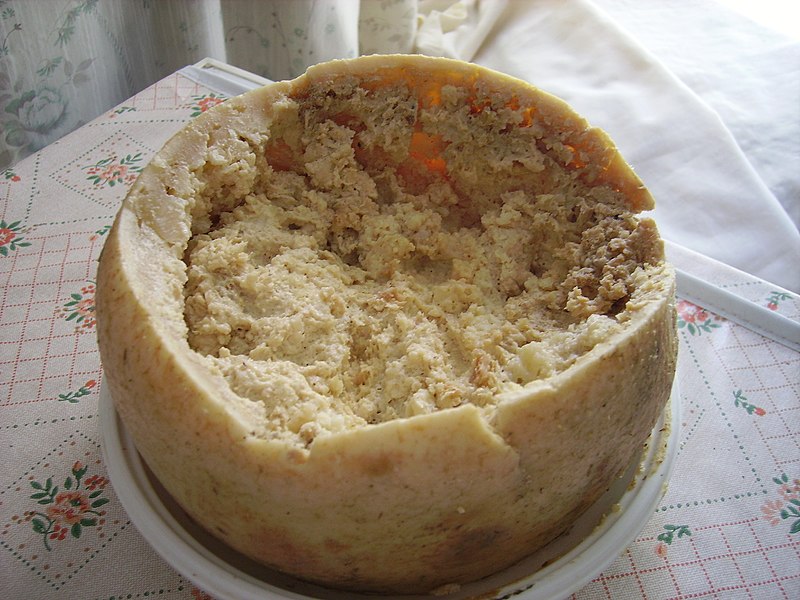
I don’t like sharing my food at the best of times, and I will fervently protect my hoard. But when faced with the challenge of sharing a deliciously stinky piece of cheese with live maggots, I’d happily accept defeat and back right off!
Casu Marzu is a specialty of the idyllic Italian island of Sardinia. The name literally translates to ‘putrid cheese,’ and if that doesn’t make you salivate, nothing will! Casu Marzu boasts a culinary history that goes back over a thousand years and has even survived a relatively (but circumvented) ban by the European Food Police who thought it ‘unsavory and unhygienic’. Apparently, we all need to be protected from gastrointestinal myasis but, to be brutally honest, what’s the travel fun in that?!
This stinky, maggot-infested bizarre food delight is produced by a simple natural process, whereby a whole wheel of pecorino-like cheese is left outside to let ‘nature do its handy work’. This results in a wonderful concoction of larvae and its…err…excrement, which gives the cheese its piquant flavor and rather crunchy texture.
We strongly suggest washing this down immediately — if not sooner — with a glass (or gallon) of strong red wine. Whatever you do, don’t sit there trying to determine where those live maggots are now living in your intestinal system. We have it on good authority that they can smell fear.
Caveat: this cheese is not suitable for vegetarians, obvs!
Balut (Fertilized Duck Egg) Laos
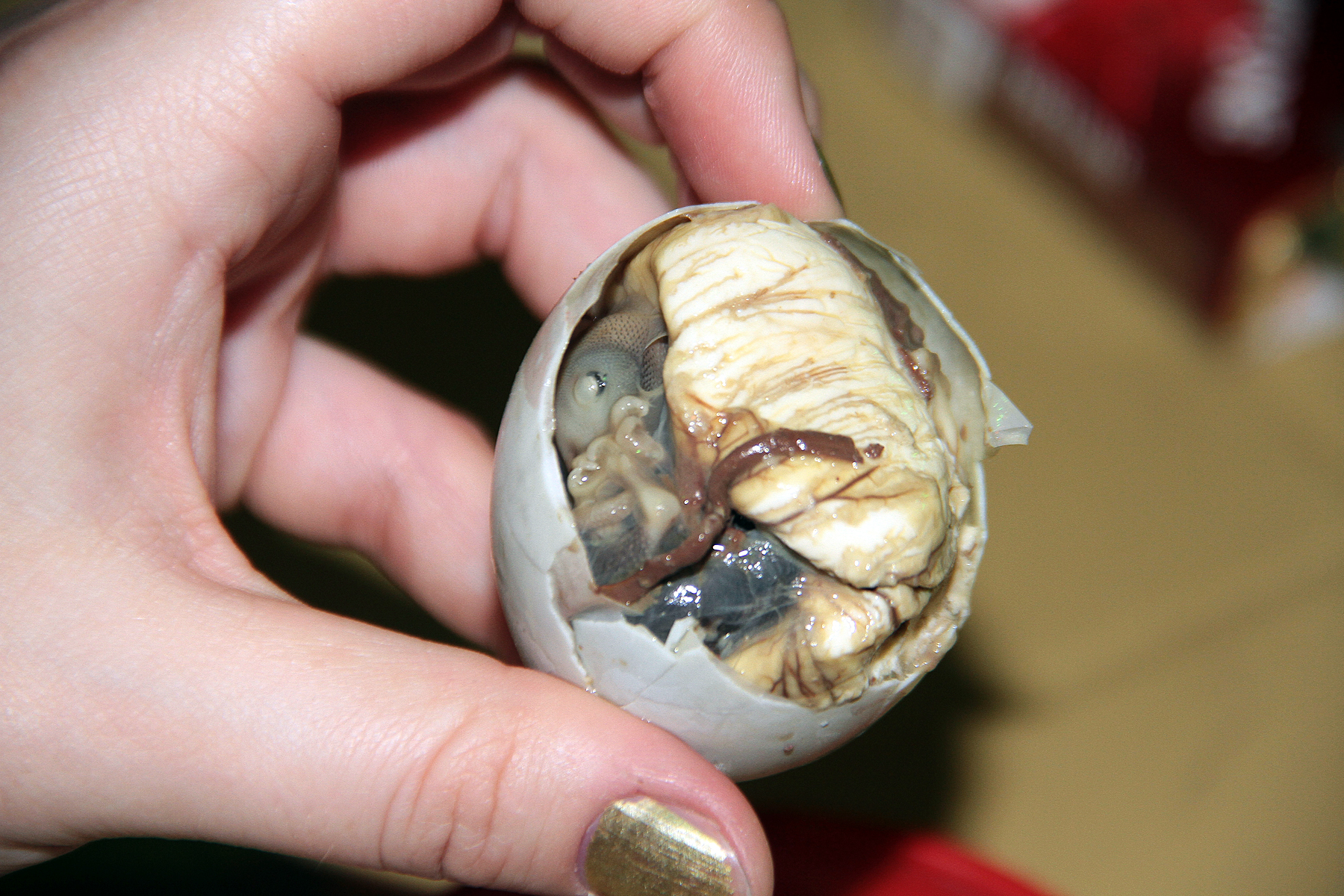
Stopping by a food cart on the side of the road in northern Laos one beautiful morning, I proceeded to buy a couple of boiled eggs from a friendly lady using a broad smile and an emphatic “song kaluna!” (two, please!)
Alarm bells should’ve gone off the moment I saw the lady’s dubious look and hesitation. Was my pronunciation that bad, I thought? Hmmm…whatevs. It wasn’t until a minute later, once I cracked open the egg shell and was confronted by a pair of bulging eyes, that it all started to make sense. I was face-to-face with one of China’s most bizarre street foods. My ensuing terror-filled scream led the seller to erupt in raucous laughter, which then turned to stern disdain once she caught sight of me flinging the embryo-in-a-shell all the way to Vietnam. I didn’t mean to waste food. It was an instinctive reaction to make it airborne!
Balut is none other than a fertilized egg, usually duck, which has been carefully incubated for up to 21 days before being unceremoniously boiled. A specialty of Southeast Asian countries, Balut is a famous local delicacy, and I’d certainly known about it yet given recent concerns in regard to animal welfare and potential health issues, I simply didn’t dream that I’d just stumble across it on a side walk in sleepy Nong Khiaw. Check out these 15 weird facts about Balut which may (or may not) make it even more appealing for you.
Moral of the story: always check your eggs before digging in and do not scroll past this point if you’re having an omelet for breakfast.
Innards Hot Pot (Questionable Animal Parts Boiled in Blood), China
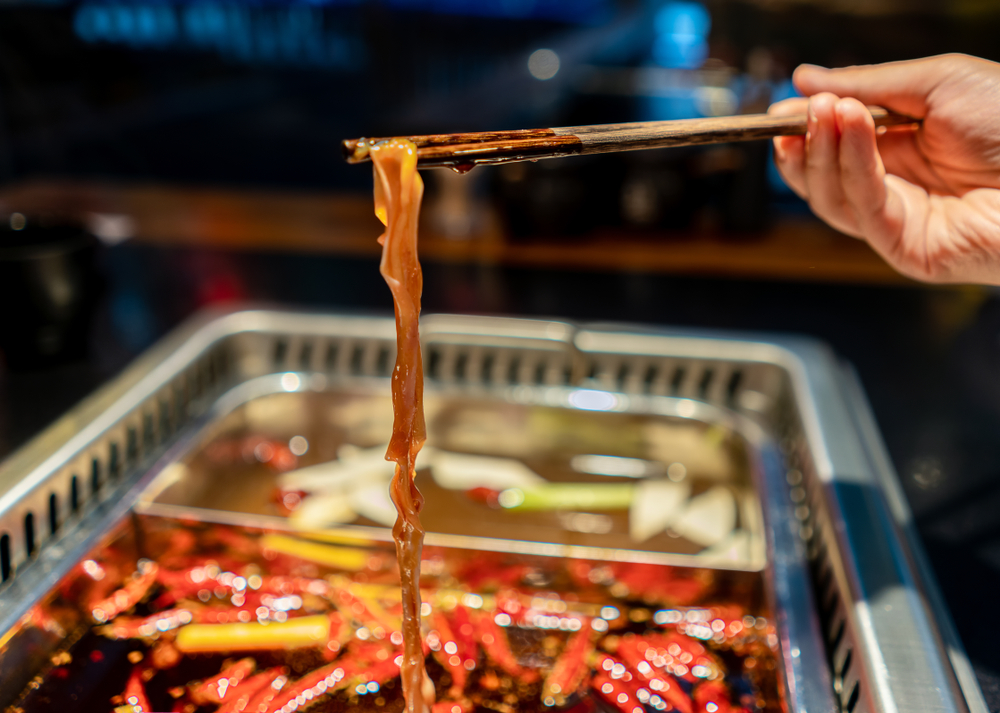
Traveling foodies tend to be much more adventurous than their static counterparts, and never is this a much-needed attribute than when traveling to China, a country that boasts impressively diverse provinces and a culinary history that predates the dinosaurs. Contrary to popular belief, China is an absolute foodie’s paradise. Well…except when it’s most certainly not.
World renowned for not wasting a single morsel of any animal, Chinese cuisine boasts traditional meals which can be a bit challenging for the Western palate (AKA, some of the food is totally bizarre). Take, for example, China’s famous (or rather infamous) spicy hot pot, a local delicacy which comes in all sorts of questionable varieties. The most questionably delightful would have to be the Sichuan variety which, luckily, comes already prepared so you don’t actually have to cook the raw tongue, throat and intestinal pieces yourself. Order one of these babies and you’ll find the meat has been boiling in the blood broth for a while already. Yes…you read that right.
Mmmm…I can still taste it! The wonderful thing about the Sichuan innards hot pot is that it’s so spicy, you almost can’t detect the bizarre textures of the flesh. Almost…
Qarta (Pan-Fried Horse Rectum), Kazakhstan & Uzbekistan
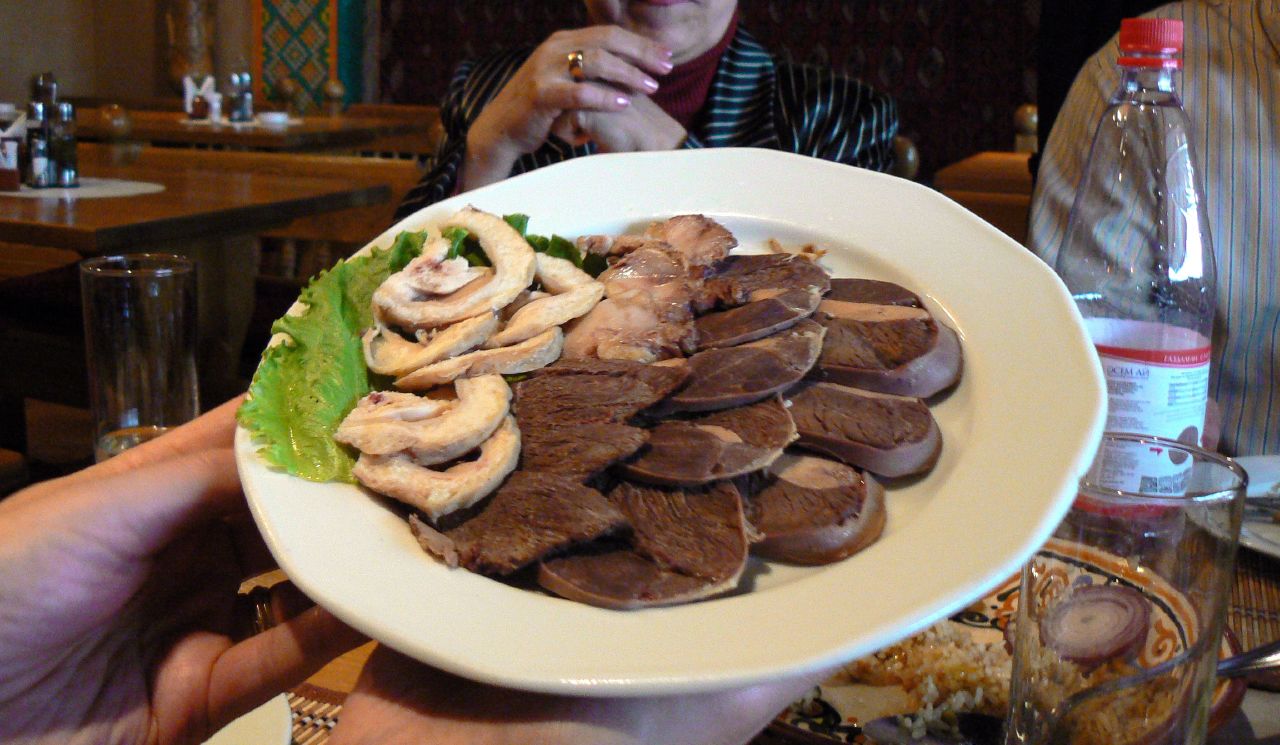
Take a road trip through Central Asia, along the ancient Silk Road, and your eyes will feast on a nearly endless array of historic treasures, like the magnificent Registan of Samarkand and Khiva’s spectacularly colorful Miri-Arab Madrasah. What you won’t find, rather disappointingly, is an immensely enticing cuisine. Despite the region’s long history of spice trade, local dishes don’t go far beyond the ubiquitous plov (a version of fried rice cooked with sheep’s fat) and lagman (a soupy noodle dish). Unfortunately, the lack of variety may lead a certain traveler (ahem) to be a bit more adventurous than usual, in the hope of eating a dish that actually requires a bit of chewing. Said traveler may even dig right into a plate of meaty goodness before enquiring as to what parts of the animal were used to make the ‘cutlets’. This traveler really should’ve known better!
Much like the Chinese, Central Asians aren’t avid food wasters, and it is from this very historic cultural trait that qarta was derived. This is one of the region’s most bizarre foods, made from the rectum of horses — the section after the intestine but just before the opening — qarta, apparently, takes some form of art to create. After being thoroughly washed and smoke-dried, the tubular lump of meat (visuals!!) is then thinly sliced and boiled in a delicious vegetable stock and served with a generous handful of dill which, let me tell you, makes all the difference.
That is, until you actually learn what it is…
Fried Brain Sandwich, Midwest, USA
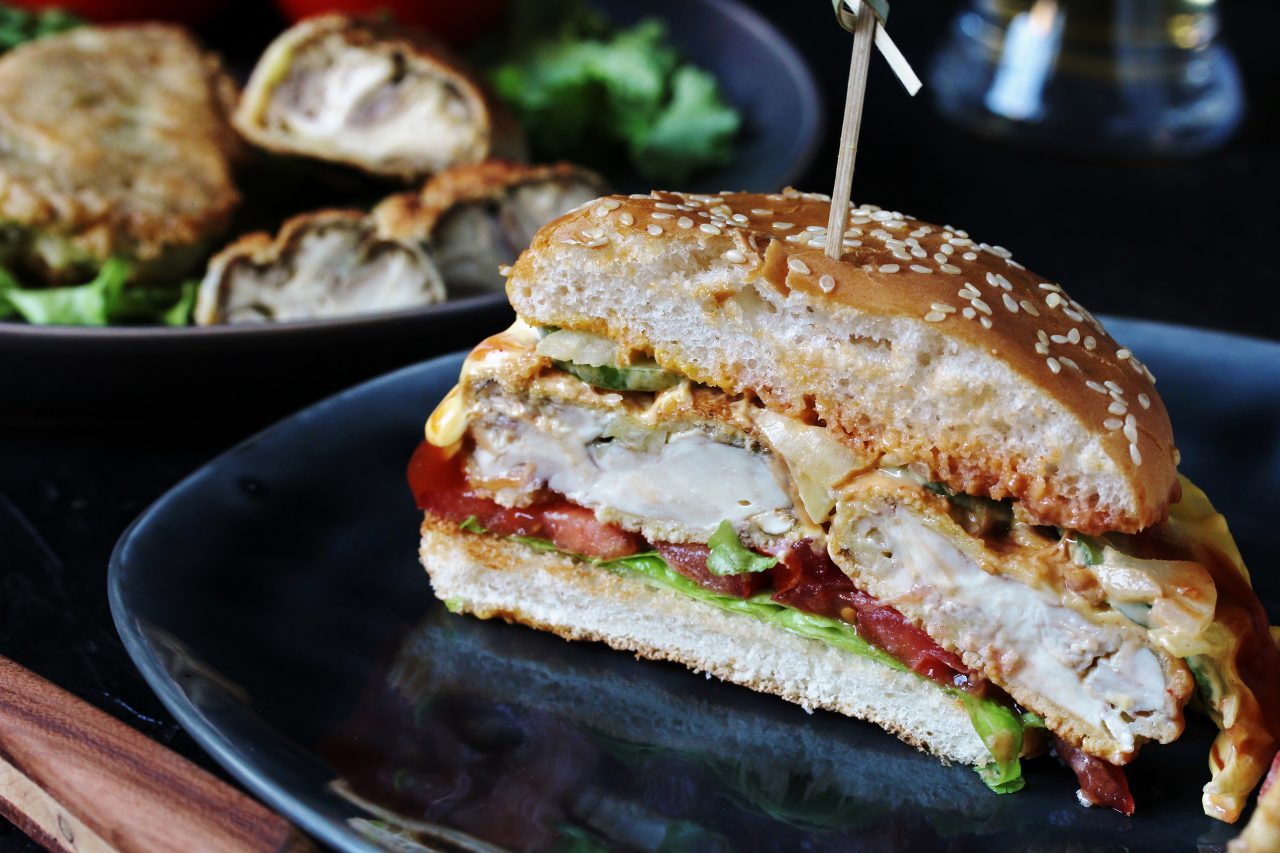
Think it’s only others who eat bizarre food? Think again!
In the Midwestern states of the USA (specifically St. Louis, Missouri), brain-feasting has been part and parcel of local cuisine for well over 200 years and you may be surprised to hear that the delicacy — borne out of need and hunger — is still served in a few select establishments.
Drowned in a concoction of mustard and pickles, the deep-fried brain is usually crisped in a cast-iron pot and served in a bun to a few curious diners who specifically seek out bizarre food. The Mad Cow Disease scare of the mid-80s put a definite dent in the market for brain sandwiches, which were, traditionally, derived from cows, yet dedicated butchers then simply marketed and used pig brains instead. Brain has a distinctively mushy texture so despite the lashings of sauce you may find it difficult to get your head around this one. Pun totally intended.
Try this morsel of yumminess at the Hilltop Inn in Evansville (Indiana) or Fergie’s Bar and Restaurant in St Louis, Missouri, among quite a few others.